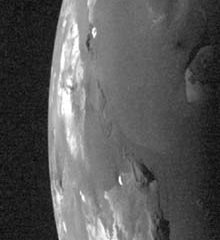This area deals with the fundamental laws and building blocks of nature and how they interact, the properties and the behavior of matter, and research into space and time and their structures.
innovations-report provides in-depth reports and articles on subjects such as astrophysics, laser technologies, nuclear, quantum, particle and solid-state physics, nanotechnologies, planetary research and findings (Mars, Venus) and developments related to the Hubble Telescope.

Lava lakes could be Ionian versions of Earth’s mid-ocean ridges
Investigations into lava lakes on the surface of Io, the intensely volcanic moon that orbits Jupiter, may provide clues to what Earth looked like in its earliest phases, according to researchers at the University at Buffalo and NASA’s Jet Propulsion Laboratory.
“When I look at the data, it becomes startlingly suggestive to me that this may be a window onto the primitive history of Earth,” said Tracy K. P. G

Debris from gobbled-up galaxy could be ’smoking gun’ for dark matter
WIMPs speeding at 670,000 mph on a “highway” in space may be raining onto Earth – a phenomenon that might prove the existence of “dark matter” that makes up most our galaxy and one-fourth of the universe, says a study co-authored by a University of Utah physicist.
Many researchers have long suspected that dark matter may be made of WIMPS or Weakly Interacting Massive Particles, which are theorized subatomic

Research paves the way to next generation of ’atomic clocks’
Three of the world’s premier measurement laboratories – including the Commerce Department’s National Institute of Standards and Technology (NIST) – have lined up the “hash marks” from four of the world’s best optical frequency rulers and declared that they match. The experiments, reported in the March 19, 2004, issue of the journal Science, are a significant step toward next-generation “atomic clocks

The number of applications requiring random numbers increases continuously. They are used for example in cryptographic applications to guarantee the secrecy of electronic communications, in scientific calculations or in chance games and lotteries. In spite of this, their generation remains a difficult task. The Group of Applied Physics and the Computer Science Department of the University of Geneva team with the company id Quantique to launch the first website allowing to download random numbers from

Thanks to ESA’s Mars Express, we now know that Mars has vast fields of perennial water ice, stretching out from the south pole of the Red Planet.
Astronomers have known for years that Mars possessed polar ice caps, but early attempts at chemical analysis suggested only that the northern cap could be composed of water ice, and the southern cap was thought to be carbon dioxide ice.
Recent space missions then suggested that the southern ice cap, existing all year round, could be a mixture

Physicists in New Zealand have shown that last November’s record-breaking solar explosion was much larger than previously estimated, thanks to innovative research using the upper atmosphere as a gigantic x-ray detector. Their findings have been accepted for 17 March publication in Geophysical Research Letters, published by the American Geophysical Union.
On 4 November 2003, the largest solar flare ever recorded exploded from the Sun’s surface, sending an intense burst of radiation